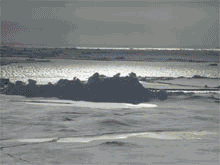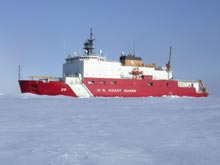
View a slide show of some images of the science activities, sea ice landscape and animals found in the Canada Basin during the Arctic Ocean Exploration in the late summer of 2002.
![]() Click
image to view a slide show.
Click
image to view a slide show.
The USCGC Healy was build to conduct research in ice-covered waters of the Arctic and was commissioned in the year 2000. Click image for larger view.
The Hidden Ocean, Arctic 2005
Rolf Gradinger
University of Alaska Fairbanks
School of Fisheries and Ocean Sciences
Background
The Arctic Ocean has experienced strong
environmental changes over the last decades. The Arctic sea ice cover extent
has decreased by about 3% per decade over the last 25 years and observations
from submarines indicate a loss in ice thickness in all parts of the Arctic.
Climate models predict, that - related to the effects of greenhouse gases
- the Arctic summer sea ice cover might be lost by 2100 which would turn
the Arctic Ocean into an ice-free ocean for several months per year. Besides
many economical implications of such changes, biological impacts will occur
with e.g., changes in the range of individual species and possible species
extinctions. The Arctic Exploration expedition in 2005 will contribute
to understanding the current diversity of life in all three major habitats
of the Arctic: sea ice, water column and sea floor.
Exploration Approach
In June/July 2005 an international team of scientists will conduct biological
investigations on the diversity of Arctic marine life using various approaches.
Scientists interested in all three major environments will study the distribution
of species in the shelf, slope and deep sea regions of the Chukchi, Beaufort
Seas and Canada Basin, allowing for a cross-comparison between environments.
Biological data will be augmented by investigations of the physical and chemical
properties of the sea water, to understand the relationships between water
temperature, salinity and its nutrient loads and biological communities.
Technology and Science Plan
The expedition will be
conducted onboard the USCG icebreaker Healy ![]() . The Healy is the newest addition to the US icebreaker
fleet and was commissioned in 2000. It provides accommodations for up to
50 scientists and is designed to break 4 feet of ice continuously at three
knots and can operate in temperatures as low as -50 degrees F.
. The Healy is the newest addition to the US icebreaker
fleet and was commissioned in 2000. It provides accommodations for up to
50 scientists and is designed to break 4 feet of ice continuously at three
knots and can operate in temperatures as low as -50 degrees F.
The icebreaking capabilities of the Healy will allow scientists to sample about 15 stations during the one month expedition covering water depths from less than 200m to about 3800m. At each station, scientist will conduct studies on ice, water and sea floor biota using different sets of tools.
Ice samples will be collected with ice corers and the help of divers. Under-ice diving is a challenging objective as water temperatures are always close to the freezing point. The samples collected will allow for unique insights into the relationship between ice structure and biology

The Global Explorer (picture shows design used during Ocean Exploration 2002) can be used to collect images, videos and specimen in water depth down to about 3000m. Click image for larger view.
An upgraded version of the remotely operated vehicle (ROV) Global Explorer will be used to explore both the pelagic (open ocean) and benthic (ocean bottom) environments in our study area. The ROV works under the ice at great depth, combining flexibility, portability and versatility in sampling and imaging operations. Its imaging tools consist of digital still-cameras and high-definition video signals. ROV studies of the water column biota will be complemented by more traditional sampling with plankton nets. A new net design (Multi-net) will allow for stratified water column sampling by remotely closing and opening individual nets. Water samples will be collected over the entire depth of the water column to analyze the chemical composition of the sea water together with continuous measurements of water temperature and salinity using a CTD (conductivity, temperature, depth) probe.
Sea floor sampling will be conducted by imaging tools. Besides the ROV, a newly developed photographic platform will be used to determine the abundance and diversity of benthic macrofauna. A drop camera will be deployed at the sea floor for up to 24 hours providing nearly continuous 360 deg photographic documentation of the life at the bottom of the ocean. More traditional benthic sampling tools, a box corer and trawls, will also be used.
Additional projects
target the mapping of the deep sea floor with the ship's sophisticated
multi-beam echosounder systems. Passive acoustic (sound) detectors will
be used to study the distribution of whales in the study area in addition
to visual observations during the cruise.
Education and Outreach
Educators, media specialists
and data managers will be involved from the beginning of the Canada Basin
expedition. One teacher from a high school in Alaska will participate in
this expedition. Lesson plans for grades 1 to 12 will be developed in a
collaborative effort between NOAA's Office of Ocean Exploration and the
participating scientists. Media representatives from Blue Land Media, ABC
news, National Public Radio and the New York Times will be onboard the
Healy for part of the cruise.
Partners
NOAA's partners in this expedition include
the University of Alaska Fairbanks, Western Washington University, Harbor
Branch Oceanographic Institute, the University of California, Monterey,
Texas A&M University, the National Ice Center, the University of
Hawaii, the Zoological Institute in St. Petersburg (Russia), the Polar
Research Institute of China, and the Shirshov Institute in Moscow (Russia).
This expedition contributes to the Arctic Ocean Diversity project (ArcOD) ![]() of the International Census of Marine Life
of the International Census of Marine Life ![]() .
.

































